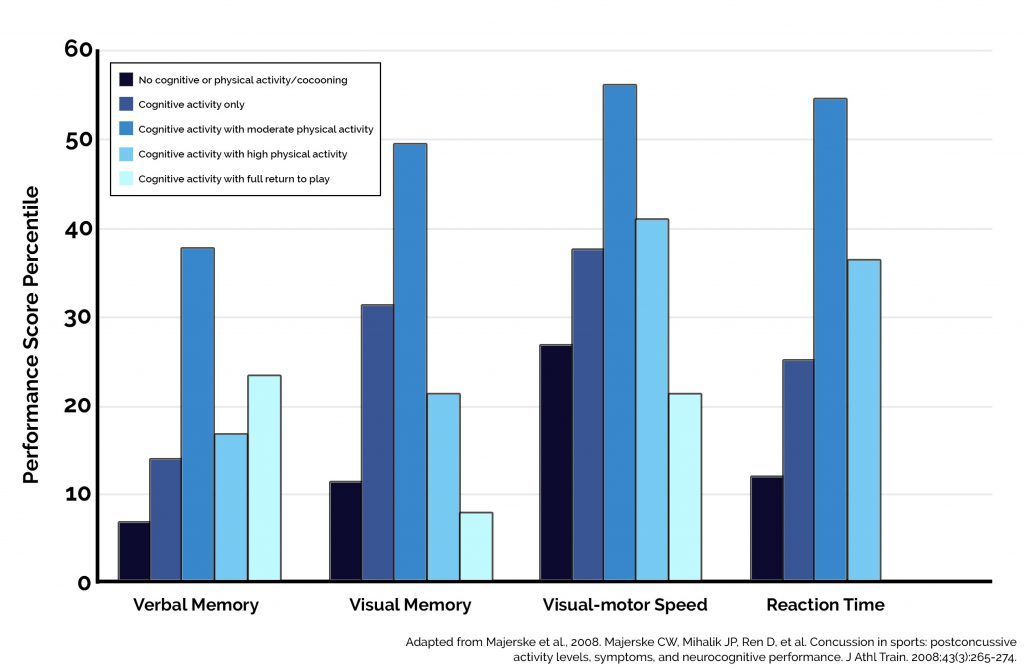Science of Concussion
For last few decades, the medical community believed that an individual should avoid all stimulus immediately following a concussion. Many medical professionals today still believe that symptoms will naturally disappear with a substantial amount of rest. However, we live in a world where we cannot afford to wait out our symptoms, and often rest alone isn’t sufficient to repair the damage that your brain has sustained.
At Neural Effects we provide a more ‘active recovery’ to get you back to your life faster and more effectively than other treatment philosophies.
If you are experiencing any of the following symptoms after your injury, please call 911 or visit the nearest Emergency Room immediately:
- Seizures
- Persistent vomiting
- Pupils of unequal size
- Blood or fluid in your ear(s)
- Increased drowsiness or lethargic behavior
- Worsening headache or neck pain
- Large bumps, bruises, or swelling on your head
What is active recovery?
Active recovery is a therapeutic method that helps reduce damage to the brain and allows you to return to a more normal life shortly after your injury. Active recovery includes two main factors: Cognitive Activity and Sub-Threshold Exercise.
Cognitive Activity can include anything from schoolwork to brain games. However, at Neural Effects, we use targeted cognitive therapies to help treat the areas that were most affected by your injury. These areas often encompass more than the point of impact as a concussion can often compress the brain and its structures on one another. Common cognitive symptoms that we treat include:
- Visual Strain or Fatigue
- Recalling memories or creating new memories
- Dizziness
- Impulsivity
- Difficulty problem solving
- Difficulty making decisions
- Sound Sensitivity
- Light Sensitivity
- Multitasking
- Processing information
Sub-Threshold Exercise allows for your brain to reregulate processes without exacerbating your symptoms. We will guide you through a variety of physical activities that help with autonomic instability and physical deconditioning. There have been several studies that have shown that sub-threshold exercise speeds up a patient’s recovery time while also decreasing the number of lingering symptoms (see figure below).
Why is active recovery better?
When your brain undergoes a traumatic event such as a concussion, the functioning of your brain changes on a cellular level. The movement that occurs in your brain during a concussion causes microscopic tears within the walls of the neuron making it hard for the cell to send signals from one neuron to another. These breaks in the cell membrane also places a strain on the neurons ability to break down sugar, making it difficult to access the energy necessary for the neuron to perform its functions. Not only does a concussion damage your neuronal cells, but it also damages the cells that transfer nutrients from the blood to the neuron in a healthy brain, a process known as Neurovascular Coupling (Dech 1091).
However, when you engage in sub-threshold exercise it allows your body to use its natural defense mechanisms to restore your neurons. There are several chemicals your body releases during exercise that heal the damage sustained during the concussion and they begin to reestablish the normal processes for your neurons.

The graph above shows that those patients who underwent a post- concussion training regimen that included cognitive activity combined with moderate physical activity had the most improvement when tested before and after their concussion treatment. Their improvement is significant compared to the patients who followed a passive recovery regimen and the patients who underwent cognitive activities while fully returning to play after their injury.